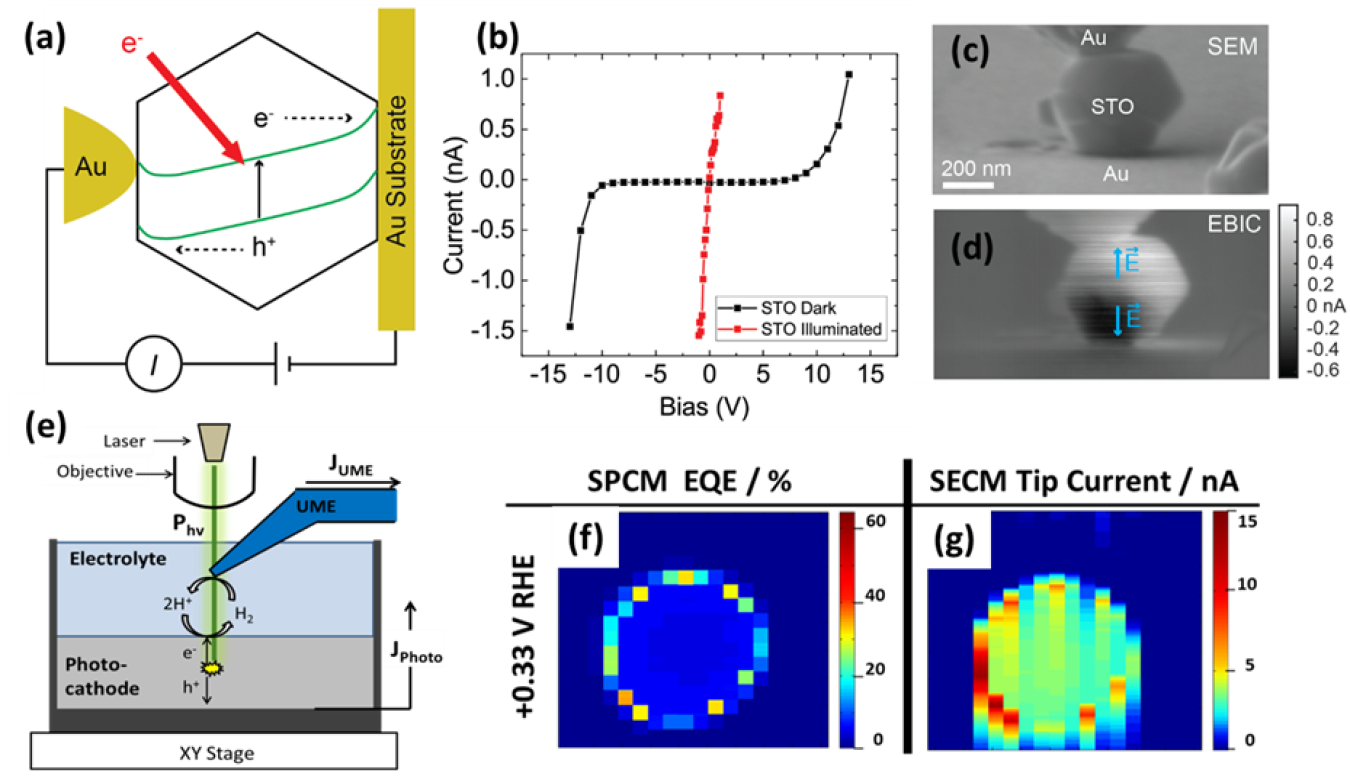
LABORATORY
Sandia National Laboratories (SNL)
CAPABILITY EXPERT
Alec Talin
CLASS
Characterization
WATER-SPLITTING TECHNOLOGY
Low-Temperature Electrolysis (LTE)
Photoelectrochemical (PEC)
Description
Our key capabilities include electron and photon based methods to map photocarrier excitation/ transport in photoelectrodes and photocatalysts, and correlating these characteristics with spatially resolved photoelectrochemical reaction rates measured in situ. We perform electron bean induced current (EBIC) in a field emission scanning electron microscope (FESEM) retrofitted with electrical nanomanipulator probes and cathodoluminescence (CL). Using this system, we routinely probe nanostructures with dimensions of tens to hundreds of nanometers and have demonstrated mapping of built-in electric fields in individual SrTiO3 photocatalysts as well as a variety of semiconductor nanostructures. [1,2] We use scanning photoelectrochemical microscopy (SPECM) and in a modified μRaman/mPL microscope with 100 nm step resolution stage and three laser excitation wavelengths (325 nm, 532 nm, and 633 nm). Using this set up we have correlated H2 evolution rates over a metal-insulator-semiconductor PEC cathode with external quantum efficiency (ECE) acquired simultaneously using the SPCM.[3,4] The addition of microRaman (collected simultaneously) provides local chemical composition of the photoelectrodes and how it evolves over time during operation.
Capability Bounds
SECM combined with microRaman spectroscopy allows electrochemical activity and composition to be measured with sub-micron spatial resolution.
Unique Aspects
Scanning (photo)electrochemical microscopy combined with microRaman spectroscopy and nanoprobing in the SEM allows electrochemical activity, carrier transport and vibration/electronic characteristics to be measured and correlated.
Availability
The capability is available to staff, students and visitors of SNL-CA in Livermore, CA.
Benefit
In situ measurements of carrier generation/transport, electrochemical reaction rates and electrode composition with high spatial resolution will help explain complex photoelectrochemical H2 evolution mechanisms.
Images

a) Schematic of (photo) carrier transport in nanophotocatalysts (nPC) for water splitting. (b) I-V curves become linear in in undoped SrTiO3 (STO) nPC under e-beam illumination. (c) SEM image and (d) EBIC image collected simultaneously revealing built-in electric fields at both Au-STO interfaces due to Schottky barriers. (e) Schematic of a cell for simultaneous SPCM and SECM measurements (f) SPCM EQE and (g) SECM H2 evolution rates mapped for a Pt/SiO2/Si photocathode. The laser source is now coupled to Raman/PL spectrometer for simultaneous vibrational and luminescence spectroscopic analysis.
References
- B. T Zutter, Z. Chen, L. Barrera, W. Gaieck, A. Lapp, K. Watanabe, A. Kudo, D Esposito, R. Bala Chandran, S. Ardo, A. Alec Talin, Single-Particle Measurements Reveal the Origin of Low Solar-to-Hydrogen Efficiencies of Visible-Light Absorbing Rh-doped SrTiO3 Photocatalysts, submitted.
- Leonard, F. & Talin, A. A. Electrical contacts to one- and two-dimensional nanomaterials. Nat. Nanotechnol. 6, 773-783, (2011).
- Esposito, D. V. et al. Methods of photoelectrode characterization with high spatial and temporal resolution. Energy Environ. Sci. 8, 2863-2885, (2015).
- Esposito, D. V., Levin, I., Moffat, T. P. & Talin, A. A. H-2 evolution at Si-based metal-insulator-semiconductor photoelectrodes enhanced by inversion channel charge collection and H spillover. Nat. Mater. 12, 562-568, (2013)
Contact us to find out more about collaboration opportunities and access the capability nodes within the HydroGEN network.

